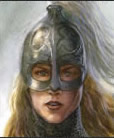The Noldor IV (the Betrayal of the Hidden Kingdoms)
The absolute defeat of the Elves at the Nirnaeth Arnoediad was followed by the ruin of the three Hidden Kingdoms – Doriath, Nargothrond and Gondolin. The destruction of each of these could be said to have been started by a human coming into each of the Elven kingdoms, carrying with them the seeds of destruction.
Doriath
The Dwarves of Nogrod eventually acquired the Silmaril that Beren and Lúthien stole from Morgoth, and they set it into a necklace called the Nauglamír. This came into the hands of Dior in Doriath, after the death of Lúthien.
When word of this came to the Sons of Fëanor, the seven of them gathered from their wanderings, and they sent a message to Dior asking him to return the Silmaril to them. Dior made no answer, and Celegorm stirred up his brothers into preparing an assault on Doriath. They arrived unannounced, and fought with Dior in Menegroth. So came about the second slaying of Elf by Elf.
Celegorm was slain by Dior, and Caranthir and Curufin fell also. From Doriath, Dior and Nimloth died, and the servants of Celegorm seized their two young sons and left them to starve in the forest. Maedhros later repented of this cruelty, and left Doriath to search for them, but he could not find them, and nothing more was ever heard of them.
A few elves managed to escape Doriath before its ruin at the hands of the Sons of Fëanor, and these included Elwing, the daughter of Dior and Nimloth. She carried the Silmaril with her, and so even after another episode of death and destruction, the Sons of Fëanor did not gain their hearts’ desire.
Nargothrond
In the case of Nargothrond, the human involved was Túrin son of Húrin. It came to pass that Túrin and Beleg Cúthalion lived in Dor-Cúarthol for a year, fighting together against the Orcs, and during that time, they were betrayed by Mîm, and Túrin was taken by Orcs. While Beleg was following their trail, he came across Gwindor lying asleep at the foot of a tree in Taur-nu-Fuin. The elf was a bent and fearful shadow of his former self – the lord of Nargothrond who had the courage to ride through the doors of Angband itself during the Nirnaeth Arnoediad. While in Angband, he had been put to work in the mines of the North, though he eventually managed to escape through some secret tunnels in the mines, and came to Taur-nu-Fuin.
Gwindor sought to discourage Beleg from his quest, but Beleg would not give up, and eventually the two of them set forth in search of Túrin. They caught up with the Orcs on Anfauglith, and found Túrin tied to a withered tree. They cut his bonds, and carried him to a nearby thicket. There Beleg cut his fetters, but nicked Túrin’s foot in the process. Túrin, coming out of a deep sleep, thought he was being attacked again, seized Anglachel, and slew Beleg.
The Noldo helped Túrin bury Beleg, and kept hold of Anglachel. The pair then wandered on long paths together, Gwindor staying with Túrin to guard and guide him in his despair. Eventually they came to Eithel Ivrin, where Túrin drank from the water and was healed of his madness. Gwindor then gave Anglachel over to Túrin, and took him back to Nargothrond to be healed and renewed.
“At first his own people did not know Gwindor, who went out young and strong, and returned now seeming as one of the aged among mortal Men, because of his torments and his labours; but Finduilas daughter of Orodreth the King knew him and welcomed him, for she had loved him before the Nirnaeth, and so greatly did Gwindor love her beauty that he named her Faelivrin, which is the gleam of the sun on the pools of Ivrin.” (Silmarillion, Of Túrin Turambar)
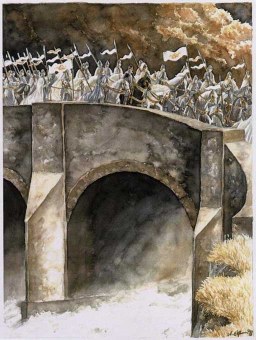
But as Túrin, under the alias of Mormegil, became high in favour in Nargothrond, Finduilas’ love turned away from Gwindor towards Túrin. When Gwindor realised this, he let Finduilas go with Túrin, but warned her that a union between Men and Elves was not fitting, and for Finduilas it would end only in sorrow. He also gave her Túrin’s real name. Thus it came to the notice of Orodreth that his guest was really Túrin, and then he gave to the man even greater honour.
Túrin came to realise that he did not like the way the Nargothrond elves fought. While he yearned for open battles, hand-to-hand fighting, the elves used stealth tactics and ambushes. As Túrin’s counsel became more and more important to Orodreth, the elves started to forsake their style of warfare, and went more openly to battle. They piled up a huge arsenal, and built a bridge across the Narog. Only Gwindor counselled against open warfare, but the King did not listen, and the elf fell into disfavour. Through this new policy of open warfare, Nargothrond finally came to the notice of Morgoth.
Some time later, Gelmir and Arminas, elves of Angrod’s people, arrived at Nargothrond. They brought tidings that Ulmo had come to Círdan, giving him warning that great danger drew close to Nargothrond. Ulmo warned Orodreth to close his doors and tear down the bridge so that evil may not find a way into the hidden city. While Orodreth was troubled by the tidings, Túrin paid no attention.
That autumn, Morgoth unleashed his troops on Nargothrond, led by Glaurung. They came down through the Pass of Sirion, defiling the Eithel Ivrin, and into the realm of Nargothrond. They burned the Talath Dirnen, the Guarded Plain, between the Narog and Teiglin. When Orodreth and his army issued forth, they found a host much greater than they had imagined and soon became penned in the field of Tumhalad, and there the glory of Nargothrond ended. Orodreth was slain, and Gwindor grievously wounded. Túrin saved him by carrying him out of the field of battle, and in a nearby wood Gwindor told Túrin to return to Nargothrond to save Finduilas and the city.
By the time Túrin had gathered up the remnants of the Elvish hosts and hastened back to Nargothrond, Morgoth’s forces were already in control of the city. The enemy had coursed over the bridge and Glaurung had burst through the Doors of Felagund, beginning the Sack of Nargothrond. Orcs killed everyone bearing arms, and plundered the halls and chambers. Women and maidens were herded onto terraces to be taken back to Angband as slaves. Túrin then hewed his way across the bridge, and came face to face with Glaurung, where he fell under the spell of the dragon and he stood unmoving as the captives – including Finduilas – were led over the bridge in front of him. At the Crossings of Teiglin, the orcs slaughtered the captives, and Finduilas, daughter of Orodreth, they pinned to a tree with a spear. Her last words were “Tell the Mormegil that Finduilas is here.” The Men of Brethil who later came across the Orcs laid her in a mound, and named it Haudh-en-Elleth, the Mound of the Elf-maid.
Glaurung then allowed Túrin to leave Nargothrond, telling him to flee to Dor-lómin, to face his fate.
Only a few elves escaped the devastation, and they survived the Fell Winter in the wilds before seeking refuge at Doriath.
Gondolin
After the defeat of Nargothrond, Morgoth turned his attention to Gondolin. There was only one problem for him – the Dark Lord still did not know the location of the Hidden City.
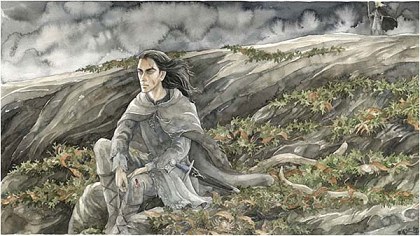
His first clue came when Húrin desired to once more go to Gondolin, and he journeyed to the Echoriath where he hoped that the eagles would find him. Indeed Thorondor saw him and took word to Turgon that Húrin was outside. Initially Turgon refused him entry, but by the time he changed his mind, Húrin had gone. From this, Morgoth reasoned that Gondolin must be somewhere in the Echoriath, though he could not get any spy into the area because of the eagles.
The actual Fall of Gondolin came about some time later, and it started with the discovery of the Halls of Vinyamar by Tuor, son of Huor and Rían. There he found the armour that Turgon had left there on the command of Ulmo many years before. Ulmo then appeared to Tuor, telling him to seek out Gondolin, and the Vala also gave him a great cloak to hide him in shadow from the eyes of his enemies. While in Vinyamar, Tuor also came across Voronwë, son of Aranwë of Gondolin, who had sailed in Turgon’s fleet to the West. After hearing of Ulmo’s words, the Noldo agreed to guide Tuor to Gondolin.
When Tuor and Voronwë reached Gondolin, they were taken to Turgon where Tuor gave Ulmo’s message to the King. The Vala’s words gave warning that the Curse of Mandos was hastening to its fulfilment, when all the works of the Noldor would perish; and bade Turgon depart and travel down the Sirion to the Sea. Turgon then remembered the words Ulmo spoke to him those many years ago, saying that the hope of the Noldor would lie in the West and come from the Sea. But Turgon was proud of the beauty of his City, and he still trusted in its secret strength – even though Ulmo had said otherwise. Furthermore, after the Nirnaeth, the Gondolindrim decided that they would never again mix in the woes of elves and men, nor return through the world to the West. Maeglin forever spoke out against Tuor, and eventually Turgon rejected the words of Ulmo.
The city was then shut tight against all – even refugees fleeing from the ire of Morgoth. From then on, tidings of the outside world came to the city came only by eagle.
“Turgon shut his ear to word of the woes without, and vowed to march never at the side of any son of Fëanor; and his people he forbade ever to pass the leaguer of the hills.” (Silmarillion, Of Tuor and the Fall of Gondolin)
Tuor and Idril
Tuor and Idril, the daughter of Turgon, fell in love and were married. Idril was wise and far-seeing, and she realised that the happiness and light of Gondolin would not last, and she created a secret way that led down from the city out to the plains, north of Amon Gwareth.
The next year, Eärendil Half-elven was born to Idril.
“Of surpassing beauty was Eärendil, for a light was in his face as the light of heaven, and he had the beauty and the wisdom of the Eldar and the strength and hardihood of the Men of old; and the Sea spoke ever in his ear and heart, even as with Tuor his father.” (Silmarillion, Of Tuor and the Fall of Gondolin)
“Now this babe was of greatest beauty; his skin of a shining white and his eyes of a blue surpassing that of the sky in southern lands – bluer than the sapphires of the raiment of Manwë; and the envy of Meglin was deep at his birth, but the joy of Turgon and all the people very great indeed.” (Book of Lost Tales II, The Fall of Gondolin)
The treachery of Maeglin
Maeglin loved mining and quarrying after metals, and he was the master and leader of the Elves who worked in the mountains distant from the city. Often he went beyond the boundaries of Gondolin in direct opposition to Turgon’s wishes. It came to pass that Maeglin was taken prisoner by Orcs, and brought to Angband. There he purchased his life and freedom by revealing to Morgoth the location of Gondolin, under the threat of great and terrible torture. Morgoth then promised Maeglin both the lordship of Gondolin, and the hand of Idril for his wife. He was then sent back to Gondolin, lest anyone suspect his betrayal, and so that Maeglin could help the invasion, when it came.
Many people put the blame for the Fall of Gondolin squarely onto Maeglin’s shoulders, and indeed it was he that precipitated the battle. But one must not forget what had led him to his destiny – including having Eöl for a father, loving Idril hopelessly, and having the Doom of the Noldor hanging squarely over his head.
“his motivation is multiple: fear, but also jealousy of Tuor the mortal, imperfect loyalty to a grandfather who killed his father, the ambitious desire for Idril which seems a last reflection of the Sindar desire to get their lands back from their supplanters. Húrin, Maeglin, Aredhel, Eöl, Curufin, Turgon: all interact to create the fall of Gondolin.” (Shippey, The Road to Middle-earth, Visions and Revisions)
The Fall of Gondolin
The account of the battle given in the Silmarillion was extremely short – simply a paragraph or two for one of the only town-based battles in Middle-earth history. However, a detailed account of the battle was given in the Book of Lost Tales 2.
When Eärendil was seven years old, Morgoth unleashed his Balrogs, Orcs, dragons and wolves on the city. They came onto the city on a night of festival, when all the people of Gondolin were upon the walls to await the rising sun. Because of this, the enemy were not stayed until they were beneath the very walls of the city.
The army of Morgoth burst into the city through the northern gate. To meet the vanguard of Orcs came the Houses of the Hammer of Wrath and the Tree, and the archers of the Swallow and the Arch rained arrows down on the invaders. But by weight of their greater numbers, the Orcs slowly forced their way into the city.
At around the same time, Tuor and his men won through to his dwelling place to find that Maeglin had reached there first. Maeglin had intended that Tuor was to be delayed by Salgant in the King’s Halls, but Salgant had become terrified, and he rode home and lay quaking on his bed. Tuor thus managed to get to his home before Maeglin could steal Idril away. Around his door were men of the House of the Mole, but Tuor and his men fought through in time to save Eärendil and Idril. Tuor cast Maeglin out over the battlements. His body hit Amon Gwareth three times in an obvious parallel with the death of his father before falling into the flames of the battle.
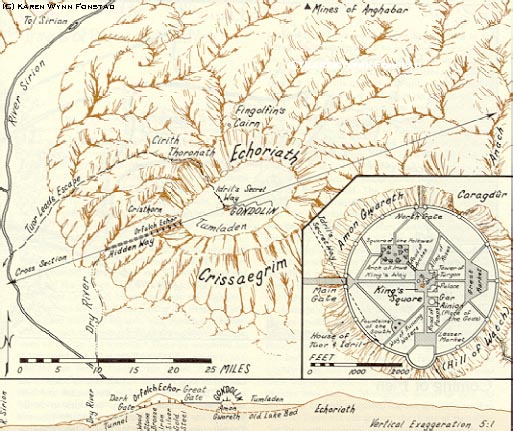
Tuor then left Idril in the care of Voronwë, and he hastened to the northern gate with his men. When he arrived, the battle at the Gate was fierce, and Duilin of the Swallow was shot by a fiery bolt from a Balrog as he even was shooting towards the enemy.
“Then the Balrogs continued to shoot darts of fire and flaming arrows like small snakes into the sky, and these fell upon the roofs and gardens of Gondolin till all the trees were scorched, and the flowers and grass burned up, and the whiteness of those walls and colonnades was blackened and seared.” (Book of Lost Tales 2, The Fall of Gondolin)
Rog then led the House of the Hammer of Wrath out to fight the Balrogs – the elves charging in a fury of wrath, sparks flying from their eyes. The number of Balrogs killed that day was told of in song from thence forth. Gothmog then sent a small force of Balrogs to slay the Hammer of Wrath, and kept the greater number back to assail the gates. Rog and his men chased the Balrogs down onto the plain of Tumladen, until they were at last hemmed in by a force of Orcs and Balrogs, when a dragon was let loose on them. It was told that each man of the Hammer of Wrath took seven lives for his own.
When the defenders of Gondolin saw the destruction of the Hammer of Wrath, they retreated further back into the city. There Penlod died in a lane, and about him many men of the Pillar and the Tower of Snow.
By that time, Morgoth’s forces held the Gate and a great part of the walls on either side, where they had killed many of the Swallow and the Rainbow. They also had won through nearly to the centre of the city, to the Place of the Well that adjoined the Square of the Palace. Then Morgoth’s commanders stopped for further counsel. They decided that they would bring forward dragons and Balrogs, but as messengers were sent back with these instructions, Ecthelion and the men of the Fountain, which until then had been held in reserve, came forward to battle. These men slew countless Orcs, and then Tuor and the House of the Wing came to stand alongside Ecthelion, and between them they harried the Orcs almost back to the Gate. But then a dragon came forth, carrying Balrogs upon it. To counter this new threat, Tuor rallied all those he could find of the Arch and the Swallow, and Ecthelion stood to the right with the men of the Fountain.
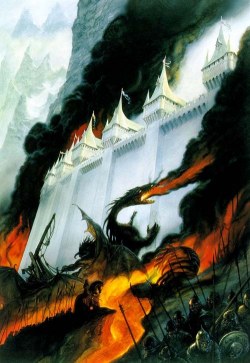
Ecthelion then slew three Balrogs, and Tuor five, before the Gondolindrim were outnumbered and were forced to fall back. Tuor had to bear Ecthelion from the battle, as his arm had been injured by a Balrog’s whip. With that retreat, the armies of Morgoth once again flooded into the city, and they came to hold half the city. The elves they slew, or took captive.
Tuor fell back to the Square of the Folkwell, and there found Galdor and his few remaining men guarding the Arch of Inwë (= Ingwë), the western entry to the square. Galdor then proved the salvation of Tuor, for the man stumbled, while still carrying Ecthelion, and the Orcs would have taken them if it was not for Galdor coming to their rescue. The remaining Gondolindrim – remnants of the Wing, the Tree, the Fountain, the Swallow and the Arch, decided to fall back to the Square of the King, which was considered more defensible.
Tuor’s force was then reinforced by Glorfindel and the last of the men of the Golden Flower and the Harp. The House of the Golden Flower had fought a battle in the Great Market and were on their way to join in the conflict at the Gate when a force of Orcs and Balrogs came upon them. They fought bitterly for hours until a fire-drake overwhelmed them, and Glorfindel and the remaining of his men retreated. As they retreated, they were reinforced by the Harp, whom Turgon had sent to aid them.
Eglamoth and the remains of the Arch and the Swallow joined Tuor and Ecthelion in the Square. Then Morgoth re-assembled his forces, and sent seven dragons to find the Square of the King, along with their attendant orcs and Balrogs. When they reached the Square, Tuor was beaten down by Gothmog, but Ecthelion, grey of face, and with his shield-arm hanging limp at his side, stood over Tuor as he fell, and battled with the Balrog, both eventually plunging to their deaths within the Fountain.
The men of the Royal House then came out to join the battle, and two score Balrogs were slain. They even hemmed in a fire-drake and forced him into the fountain to his death. The death of the fire-drake in the fountain caused all the water within to boil up, and it filled the square with burning steam and blinding fogs, and many of the Gondolindrim were killed there.
There was one last rally of the elves, starting under the images of Glingal and Belthil. But Turgon had lost hope, and cast down his crown. While he allowed Tuor to lead his people out of the city using Idril’s escape route, he refused to leave. The folk of his House then also refused to leave, and gathered around the base of the King’s Tower.
After the Gondolindrim left, Morgoth’s army continued on into the King’s Square. The dragons crushed the base of the Tower, which collapsed in a pile of flame and fire. Thus fell Turgon, King of Gondolin.
The flight of the Gondolindrim
Tuor and Idril then led as many Gondolindrim as they could gather out through the secret way. On the way out of the city, Glorfindel held the rear, and many of the House of the Golden Flower fell. The Book of Lost Tales 2 also mentions a Legolas Greenleaf of the House of the Tree in that flight.
When the refugees reached Cirith Thoronath, they were set upon by Orcs and a Balrog. Glorfindel then fought the Balrog, and both fell to ruin in the abyss. Eagles then flew down to aid the refugees, and drove the Orcs back so that all were slain or cast into the deeps. Thus words of the escape of Tuor did not come immediately to Morgoth’s ears. At that time, around 800 elves were in the group of refugees.
Thorondor bore up Glorfindel’s body out of the abyss, and he was buried in a mound of stones beside the pass. A green turf came to lie there, and yellow flowers bloomed upon it.
Eventually the refugees came to Nan-tathren, the Land of Willows, and there they rested for a while. They made a feast in memory of Gondolin, and the Elves that had died there, and for Glorfindel the beloved. The Gondolindrim then departed from the Land of Willows, and made their way down to the Mouths of Sirion, and joined their people to the company of Elwing. There, an Elven-folk was established from the remnants of Doriath and Gondolin, and from Balar the mariners of Círdan came among them. When word came to Balar that Turgon was slain, Gil-galad was named High King of the Noldor in Middle-earth.
When Tuor grew old and weary, he fashioned a ship called Eärrámë, and he and Idril set sail into the sunset and the West.
Canonicity of the BoLT story
The Silmarillion covers the Fall of Gondolin in a simple few paragraphs, and the only detailed account known is the one in the Book of Lost Tales 2. It is striking to note that the few details mentioned in the Silmarillion are identical to those in BoLT (e.g. Maeglin’s body hitting Amon Gwareth three times before falling into the flames), and Christopher Tolkien, in his commentary on the BoLT story suggests that most changes between the two versions are simply as a result of compression rather than any significant change in the course of events.
The one main difference, of course, is the number of Balrogs in the battle – a change which does not affect the story of the Noldor in any way. Tolkien’s early concept of Balrogs had them as demons of powers, capable of pain and fear, and less terrible and more destructible than their later counterparts. The Balrogs of the Silmarillion were another matter all together.
The Exiles from the Hidden Kingdoms
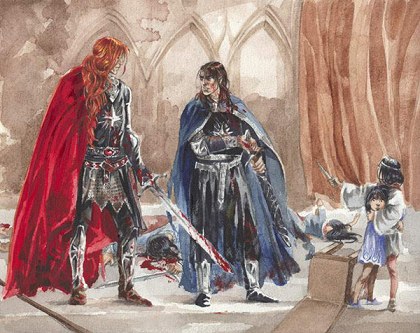
The Sons of Fëanor came down suddenly on the exiles of Doriath and Gondolin at the Mouths of the Sirion, and destroyed them in the third Kinslaying. Both Amrod and Amras were killed, and Maglor and Maedhros were the only remaining Sons of Fëanor. The few people who did not die in the assault joined themselves to Gil-galad, and went with him to Balar. Elros and Elrond were taken capture, and Elwing cast herself into the sea, with the Silmaril upon her breast.
Maglor and Maedhros discovered the fate of one of the Silmarils when they saw Eärendil rise into the sky.
“Maedhros spoke to Maglor his brother, and he said: “Surely that is a Silmaril that shines now in the West?”
And Maglor answered: “If it be truly the Silmaril which we saw cast into the sea that rises again by the power of the Valar, then let us be glad; for its glory is seen now by many, and is yet secure from all evil.”” (Silmarillion, Of the Voyage of Eärendil and the War of Wrath)
This quote says everything about Maglor’s state of mind at that point. He had come to see that the defeat of evil was of greater importance that his adherence to his Oath. He took pity on the captive Elrond and Elros, and looked after them well. They grew to love each other, though Maglor’s heart was sick and weary with the burden of his Oath.
The War of Wrath
Morgoth thought that through the First Age he had managed to permanently divide the Eldar and the Valar, and that the Valar were so content in Aman that they would not bother to defend Middle-earth if he launched an attack. But he was wrong, and when he came forth to battle, the Valar came to war, and with them marched the Vanyar, and those of the Noldor who had stayed in Aman. These were led by Finarfin.
At the end of the War, the final two Silmarils were taken from Morgoth’s crown, and were given into the care of Eönwë, the herald of Manwë. Eönwë then summoned the Elves of Beleriand to make ready to depart from Middle-earth back to Aman, but Maglor and Maedhros would not listen, and though they were filled with weariness, loathing, and despair, they still tried to fulfil their oath.
“for they would have given battle for the Silmarils, were they withheld, even against the victorious host of Valinor, even though they stood alone against all the world.” (Silmarillion, Of the Voyage of Eärendil and the War of Wrath)
They then sent a message to Eönwë, bidding him to give up the jewels which were rightly the possession of the House of Fëanor. Eönwë refused, telling Maglor and Maedhros that their House’s claim to the jewels had passed away because of their merciless deeds – especially the slaying of Dior and the assault on the Havens. He bade them return to Valinor and face the judgement of the Valar, by whose decree alone Eönwë would yield the jewels from his charge. Maglor desired to submit to Eönwë, for his heart was sorrowful, and he thought that in Valinor they may be forgiven and therefore come into their own. But Maedhros said that if they returned to Valinor but were not forgiven, then the Oath would be beyond their powers to fulfil.
Maglor eventually submitted to Maedhros’ will, and they disguised themselves and went to Eönwë’s camp, where slew the guards and took the jewels. Then, as the camp was raised against them, they prepared to die, but Eönwë would not allow his guards to kill them and the brothers fled. Each took one Silmaril.
The jewel Maedhros took burnt his hand with unbearable pain, and he realised that Eönwë had been right – that his right was void, and his oath in vain. He cast himself into a chasm filled with fire, and the Silmaril he bore was taken down into the earth.
Maglor at last threw his Silmaril into the sea, not able to endure the pain. Thereafter, he wandered ever upon the shores, singing in pain and regret beside the sea. He never went back among the Elves.








